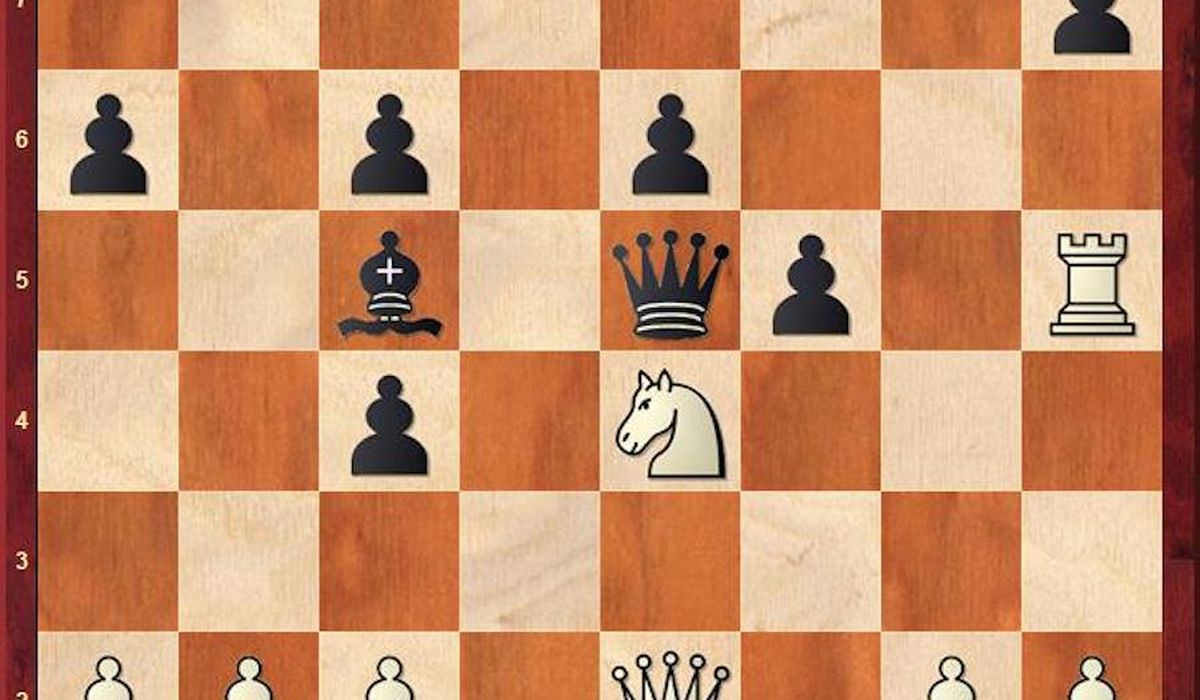
While some traditional over-the-board tournaments are now coming back to life, the COVID-19 scare is still proving too much for the biennial Chess Olympiad, given the logistical and safety concerns of hosting nearly 200 open and women’s teams from around the world.
Still, FIDE’s monthlong “Online Olympiad 2021” is proving a decent second-best alternative, with 155 national squads competing in rapid matches that culminated in an eight-country knockout playoff. In a nice twist, the six-player squads are balanced with at least two female stars and two under-20 junior players.
Anchored by GM Jeffery Xiong and Ray Robson, the U.S. team put on a spirited run, upsetting India in the semifinals before losing out on the gold medal in last week’s finals to Russia.
Russia’s strong female contingent — GMs Kateryna Lagno, Aleksandra Goryachkina and former women’s world champ GM Alexandra Kosteniuk — proved critical to the win, with Kosteniuk’s brilliant win over eight-time U.S. women’s champ Irina Krush pivotal to the close winning margin.
Krush upset Indian GM Humpy Koneru in their semifinal rapid match but ran into a combinational buzz saw against Kosteniuk. Those who play the Sicilian Richter-Rauzer are used to living on the edge, but here Krush fails to find the answer to White’s brutal kingside push.
After 13. Re3 (White’s plan is easily summarized — checkmate) Rg8 14. f4 d5!, Krush gets in the classic Sicilian freeing move that should give Black equality, but she appears to underestimate the danger still lurking in the position: 17. fxe5 Bc5?! (safer was 17…Bc7 18. Kb1 Qg5 19. Bd3 Rb8, with equal chances) 18. Rh3! (a piece offering Black would have been wise to decline) Qg5+ 19. Kb1 dxc4?! 20. Ne4 Qxe5 (Qxg2 appears to fall short to 21. Rxh7+! Kxh7 22. Nf6+ Kh8 [Kg7?? 23. Qxg2+] 23. Qh5+ Kg7 24. Qh7+ Kf8 25. Qh6+ Qg7 26. Rd8+ Ke7 27. Rxg8! Qg1+! [Qxh6 28. Re8 mate] 28. Rxg1 Bxg1 29. Qd2 Bc5 30. Qa5! Bd6 31. exd6+ Kxf6 32. Qd8+ Kf5 33. d7, and Black is out of tricks) 21. Rh1 f5 (see diagram; on 21…Qg7 22. Rg5 Qh6 23. Rxg8+ Kxg8 24. Nxc5, Black is in a nasty bind), and now the Russian star gives a clinic in how to exploit an overworked defender.
Three straight star moves wrap up the contest: 22. Ng5! Qc7 (Qxe2 allows 23. Rxh7 mate, while 22…Qg7 23. Qe5!! leaves Krush in the same pickle as in the game) 23. Qe5+! Rg7 (Qxe5 24. Rxh7 is again mate) 24. Rd8+! (the final indignity for the harried Black queen; Krush sportingly plays things out to the end) Qxd8 25. Rxh7+ Kg8 26. Qxg7 mate.
—-
He once had a reputation for not always playing his best before the home crowd, but Norwegian world champ Magnus Carlsen has put that decisively to rest with his third straight win in the latest EY Norway tournament in Stavanger, Norway. Carlsen’s strong second-half performance in the six-GM round-robin event was made even sweeter by the fact that he defeated Russian GM Ian Nepomniachtchi twice in armageddon playoff games after the two drew their games at classical time controls, earning at least a psychological edge ahead of their upcoming world title match in November.
Young French-based Iranian GM Alireza Firouzja also enjoyed a strong second half in the event to pass Hungarian front-runner GM Richard Rapport for second place. The last-round game between the two rising superstars was one of the most intriguing of the event, with the 18-year-old Firouzja finding a rook sacrifice over the board that led to a complex but ultimately successful mating attack.
It’s a sharp Rossolimo Sicilian line that Firouzja makes even sharper with 10. d4 cxd4 11. Qxd4!!? (Qa4+ Nc6 12. Nd5 was another way to fight for the initiative; White calculates he will win back the knight and get a raging attack in compensation for the lost exchange) Nc2 12. Qe4 Nxa1 13. Bf4 Be6 14. Rxa1 Rc8, and Rapport is a long, long way from unraveling his undeveloped kingside.
The tactics are way deeper than we can go into here, but White’s persistent efforts to blow open attacking lines pays off on 16. Nxe5 f6?! (g6 was suggested here, along with 16…Rxc4!? 17. Qxc4 Qxd5 18. Qxd5 Bxd5 19. Rc1 Be6 20. Rc7, with unclear play) 17. Nf3 Bxd5 18. cxd5 Rc5 19. d6! Qd7 (Black’s planned 19…e5 would have been met by 20. b4!! Rb5 21. a4! Rb6 22. Nxe5! fxe5 23. Qxe5+ Kf7 24. Qd5+ Kg6 25. g4!, with crushing mate threats) 20. b4!, forcing the rook has to cede his defensive post on the fifth rank.
There are still twists and turns before White clinches the point: 22. Nd4 e5 23. Qd5+ Kg6 24. Bxe5! Rxd6 (fxe5 25. Nf3! — a powerful retreat— Bxd6 26. Nxe5+ and wins) 25. Bxd6 Bxd6 (material is equal once again, but Rapport has not fully escaped White’s pressure) 26. Qe4+ Kf7 27. Qd5+ Kg6 28. g3! (careful play — the hasty 28. Nf5? Bxh2+ 29. Kxh2 Qxf5! [Qxd5?? 30. Ne7+] saves the game for Black) h6 29. Rd1 Re8 (Rd8 30. Ne6 wins, but the pinned Black bishop will soon prove fatally vulnerable) 30. Nf3! Re6 31. Nh4+ Kh7 32. Qd3+! (one last minefield avoided: 32. Nf5?? Re5! holds), and Black resigned as on 32…Kg8 33. Nf5, the bishop can’t be saved.
Kosteniuk-Krush, Russia-U.S. Match, FIDE Online Olympiad, September 2021
1. e4 c5 2. Nf3 d6 3. d4 cxd4 4. Nxd4 Nf6 5. Nc3 Nc6 6. Bg5 e6 7. Qd2 Be7 8. O-O-O a6 9. Nxc6 bxc6 10. Bxf6 gxf6 11. Bc4 O-O 12. Rhe1 Kh8 13. Re3 Rg8 14. f4 d5 15. Qe2 Bd6 16. e5 fxe5 17. fxe5 Bc5 18. Rh3 Qg5+ 19. Kb1 dxc4 20. Ne4 Qxe5 21. Rh5 f5 22. Ng5 Qc7 23. Qe5+ Rg7 24. Rd8+ Qxd8 25. Rxh7+ Kg8 26. Qxg7 mate.
Firouzja-Rapport, 9th EY Norway tournament, Stavanger, Norway, September 2021
1. e4 c5 2. Nf3 Nc6 3. Bb5 Nf6 4. Nc3 Nd4 5. e5 Nxb5 6. Nxb5 Nd5 7. O-O a6 8. c4 Nb4 9. Nc3 d6 10. d4 cxd4 11. Qxd4 Nc2 12. Qe4 Nxa1 13. Bf4 Be6 14. Rxa1 Rc8 15. Nd5 dxe5 16. Nxe5 f6 17. Nf3 Bxd5 18. cxd5 Rc5 19. d6 Qd7 20. b4 Rc6 21. Re1 Kf7 22. Nd4 e5 23. Qd5+ Kg6 24. Bxe5 Rxd6 25. Bxd6 Bxd6 26. Qe4+ Kf7 27. Qd5+ Kg6 28. g3 h6 29. Rd1 Re8 30. Nf3 Re6 31. Nh4+ Kh7 32. Qd3+ Black resigns.
• David R. Sands can be reached at 202/636-3178 or by email at [email protected].








